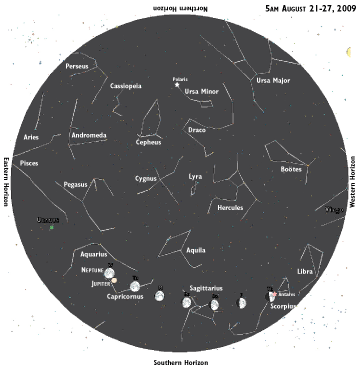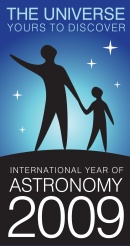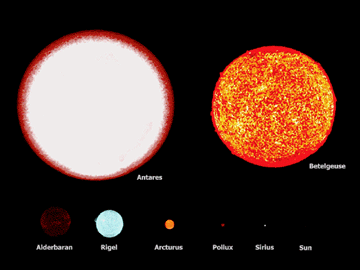
Volume XVII, Issue 35 # August 27 - September 2, 2009 |
 |
 |
 Sky Watch
Sky Watch
by J. Alex Knoll
It’s All a Matter of Scale
While our sun is the biggest light in our lives, it’s a puny star
It’s easy to get lost in the cosmos gazing at a star-filled sky these late-summer nights. Yet looking at a backdrop of tiny, glowing lights with our feet planted on terra firma, you may not realize just how vast space truly is — and, by extension, how small we are.
 The waxing gibbous moon reaches first-quarter Thursday, appearing low in the south at sunset, before 7:45 this week. The red light shining beside the moon’s outer edge is Antares, the lead star in the constellation of Scorpius.
The waxing gibbous moon reaches first-quarter Thursday, appearing low in the south at sunset, before 7:45 this week. The red light shining beside the moon’s outer edge is Antares, the lead star in the constellation of Scorpius.
While we see the moon dwarfing Antares, the truth is  something altogether different. Located some 500 light years from us, this super-giant burns 10,000 times brighter than our own sun. Astronomers have long known that
something altogether different. Located some 500 light years from us, this super-giant burns 10,000 times brighter than our own sun. Astronomers have long known that![]() Antares is far more massive than the sun. But more recent observations with NASA’s orbiting infrared Spitzer Space Telescope have revealed a massive nebula surrounding Antares, making its diameter more than 700 times that of the sun.
Antares is far more massive than the sun. But more recent observations with NASA’s orbiting infrared Spitzer Space Telescope have revealed a massive nebula surrounding Antares, making its diameter more than 700 times that of the sun.
In place of our own sun, Antares would engulf our solar system almost to Jupiter. In the to-scale comparison at right, our sun disappears. Yet astronomers continue to find ever larger stars, the biggest today being VY Canis Majoris, a hyper-giant 5,000 light years away and more than 2,000 times the size of our sun.
Illustration: © Copyright 1925 M.C. Escher/Cordon Art-Baarn-Holland; Graphics: © Copyright 2009 Pacific Publishers. Reprinted by permission from the Tidelog graphic almanac. Bound copies of the annual Tidelog for Chesapeake Bay are $14.95 ppd. from Pacific Publishers, Box 480, Bolinas, CA 94924. Phone 415-868-2909. Weather affects tides. This information is believed to be reliable but no guarantee of accuracy is made by Bay Weekly or Pacific Publishers. The actual layout of Tidelog differs from that used in Bay Weekly. Tidelog graphics are repositioned to reflect Bay Weekly’s distribution cycle.Tides are based on National Oceanic and Atmospheric Administration and are positioned to coincide with high and low tides of Tidelog.
